Betta Care Sheet
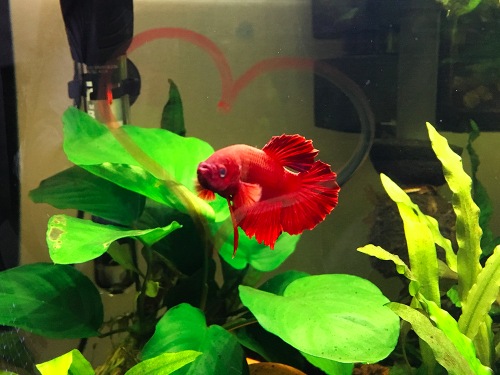
Quick Facts
- Scientific name: Betta splendens
- Other common name(s): Betta, Siamese fighting fish, beta fish
- Lifespan: 2-3 years
- Average adult size: 2-3″ (5-7cm)
- Temperament: Aggressive toward other betta fish. A betta can potentially be a member of a peaceful community tank, although research must be done to ensure compatibility. Success also depends on the temperament of the individual fish.
- Diet: Insectivore/carnivore
- Freshwater
- Tank size: A minimum of 5 gallons. Larger setups with established cycles typically mean less work for you and less stress for the fish.
- Tank region: Top. Be sure to always give bettas access to the surface to breathe since they need atmospheric oxygen as well as dissolved oxygen. Placing decorations and plants that reach all the way to the surface is a must as well.
- Ideal temperature: 76-82F (with 78-80 often being the preferred). Bettas need stable tropical temperatures, so be sure to invest in a good submersible heater and glass thermometer.
- pH range: Ideally between 6-7.
Appearance

Bettas are usually 2-3″ (5-7cm) and known for their bright colours. They typically have streamlined bodies (except for doubletails, which are usually shorter and stockier) with flowing fins.
Bettas are available in many tail types, colours, and patterns. The most common fish you’ll see in the trade are blue and red veiltails because red and blue are dominant traits while the veiltail tail type is also the dominant trait.
Here is a list containing different kinds of betta appearances:
Tail Types
- Veiltail
- Crowntail
- Halfmoon
- Over-halfmoon
- Delta
- Super delta
- Plakat
- Doubletail
- Rosetail
- Feathertail
- Combtail (or Half Sun)
- Roundtail (or Singletail)
- Spadetail
- Giant
- King
- Dumbo (or Elephant Ear)
Want to see examples of these tail types?
Colours and Patterns
Solids:
- Red (red, extended red, and red loss)
- Blue (steel blue, royal blue, and turquoise)
- Orange
- Yellow
- Cellophane
- White opaque
- Copper
- Metallic
- Gold
- Black (melano and super black)
Bi-Colours:
- Mustard gas
- Chocolate
Others:
- Salamander (yellow and purple)
- Butterfly
- Orange Dalmatian
- Cambodian
- Dragonscale
- Samurai
- Marble
- Koi (red and yellow – also still considered to be marble)
- Black Orchid/Black Lace
- Mask
- Pineapple
- Grizzle
- Piebald
- Samurai
- Armageddon
- Monster
Multicolour:
- Basically any colour that doesn’t fit into any other category
Want to see example of colours and patterns?
Please note that the colour and pattern guide is in no way definite. New colours and patterns are always being developed and standardized. A lot of betta titles on Aquabid that breeders use are typically more eye-catching names of colours and pattern more commonly known from above.
I don’t yet have a colours and patterns guide but hope to create one in the future! Interested in submitting pictures to potentially be included? Submit here!
Behaviour
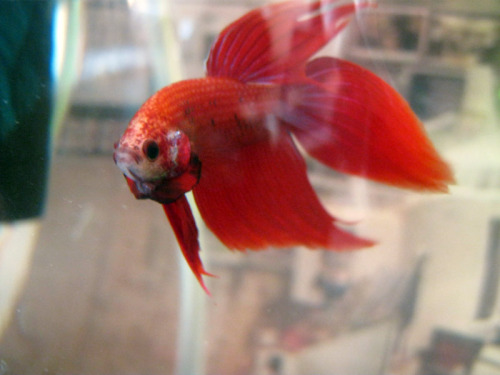
Bettas are amazing fish with plenty of energy, mountains of curiosity, and a big appetite. In fact, to help give you a better idea of betta behaviour and what is considered to be healthy or not, please refer to my guide here:
Bettas also have lots of personality, which is one of the reasons they’re so popular as pets. Here are four basic betta personalities I have observed:
1. Aggressive. Aggressive bettas are typically high-energy and will flare at everything – whether it moves or not. They are very territorial and should not be kept with other tankmates. Because they are always in fight mode, they stress more easily and may leave themselves susceptible to illnesses caused by a compromised immune system.
2. Nervous. Nervous bettas tend to hide away from everything and rarely make their presence known. Even things that they are familiar may cause them to become stressed. Nervous bettas tend not to flare often.
3. Passive. Passive bettas are relaxed and go with the flow. They tend to rest a lot but should still be alert and regularly patrol their tanks. They tend to rarely flare.
4. Curious. Curious bettas never stop moving but don’t share the same attack instincts as aggressive bettas. They are often found actively patrolling their territory and checking every nook and cranny. They will always try and catch your attention and tend not to flare much.
It’s important to note that a betta’s health will affect its overall energy level and mannerisms. For example, a nervous betta may be a sign that the tank needs more plant cover or that it may be sick. Again, please refer to the Healthy Vs. Unhealthy Betta Fish guide to determine if your betta’s personality or behaviours is something to be concerned about.
Tank Requirements

As mentioned above, the minimum tank size requirement is 5 gallons. Although a lot of people (including myself in the past) say that 2.5 gallons is the minimum, it’s really too small and not safe enough for bettas. Whenever possible, go at least 5 gallons or above. I can go on and on about the benefits of housing your betta in a larger aquarium. Ultimately, larger setups mean less work for you and less stress for the betta.
To learn more about tank requirements, check out:
- Betta Care: 7 Tips for Building a Simple Betta Tank
- Pet Supplies You Need to Care for Your Betta Fish
Diet and Feeding
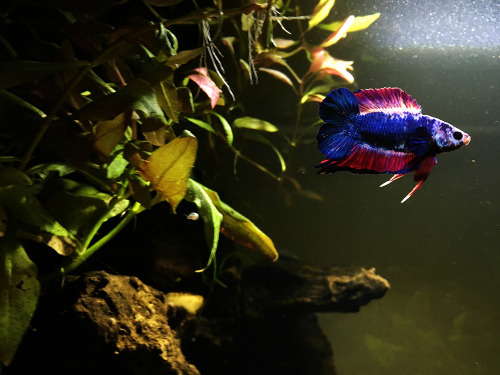
Bettas are primarily insectivores (as evident by their upturned mouths designed to pick off insects from the water surface). As with most creatures, they require a high-quality, high protein, and varied diet to thrive.
The basic types of food available for bettas include:
- Flake food. This food is often considered to be the least healthy for bettas. They’re often packed with fillers and are notorious for causing bloat and dirtying the water faster.
- Pellets. Pellets, such as Omega One and New Life Spectrum, are popular choices amongst betta owners. The food is rich in protein and bettas typically don’t have a difficult time eating them. Most betta owners prefer using pellets as the primary food.
- Freeze-dried. There are plenty of freeze-dried insects on the market, such as bloodworms, brine shrimp, and daphnia. They’re good for occasional treats.
- Frozen. Frozen bloodworms thawed in conditioned water is the favourite food of many bettas. Some betta owners use frozen bloodworms as the primary food while others only give them as weekly treats. Either way, bettas should have access to frozen food. My bettas are personally much more fond of frozen brine shrimp.
- Live. Live food, such as baby brine shrimp, is commonly fed to betta fry (although most adults enjoy baby brine shrimp as well). Other common live foods include daphnia, bloodworms, blackworms, and grindal worms. However, keep in mind that live foods, especially bloodworms, may carry parasites.
When it comes to the feeding schedule, most owners feed their bettas small amounts of food twice daily. For example, 5 pellets for each meal. To help flush out their digestive tract, many owners also choose to fast their bettas for one day a week. Nowadays, I personally feed mine once daily with one or two fasting days.
After every meal, be sure to remove any uneaten food to avoid dirtying your water. Turkey basters work great for getting out small bits of food between water changes.
It’s also important to vary the diet to ensure that your betta gets all the nutrients and amino acids it needs. Fatty liver disease seems to be on the rise in bettas and is believed to be the result of owners only using one kind of food for feeding (and overfeeding). If you use an all-pellet feeding schedule, for example, it’s highly recommended to use at least two or three different brands at the same time to ensure that your betta gets a wider range of amino acids in its diet. Additionally, you can soak all types of food in products such as Seachem Nourish, which is a supplement.
Possible Tank Mates

Betta splendens are aggressive and best kept alone. A betta’s true personality shines through best when it has the whole tank to itself. Bettas are solitary creatures and don’t get “lonely” or “need friends”. There are some wild types, such as Betta albimarginata, that can be kept in pairs or small groups but even this is not without its risks and requires thorough research.
Betta Sororities
Do not attempt a betta sorority. Some people mistakenly believe that female bettas are less aggressive than their male counterparts and insist on keeping a group of them. This is, in my opinion, a cruel practice. A betta sorority purely exists for the human ego and does not in any way benefit the fish.
Here’s why betta sororities are a no-go:
1. Bettas are regularly stressed and injured.
It’s extremely common to see torn fins, dull colours, stress lines, and both aggressive and/or nervous behaviours in at least one girl in the sorority. These fish are living their lives constantly in a fight-or-flight state.
2. Bettas are sometimes killed.
It’s not uncommon for the sorority to turn on a “sister”. In a lot of cases, this is done by more dominant females toward a less dominant female (although any betta can be targeted for whatever reason). I’ve heard and seen a lot of horror stories about the violence that ensues. It’s not unheard of for the bettas to go on a murderous rampage, even after years of being in a “successful” sorority.
3. Illnesses and diseases spread faster.
With a large group of stressed and fighting females (that may not all have come into the group healthy to begin with), dealing with tank-wide illnesses and disease is common. Do you have enough medication for all those females? Do you have adequate space and equipment elsewhere for separating sick individuals?
4. You’ll need a lot more equipment!
Do you have the money for multiple fish aquariums if any females need to be separated? Do you have multiple setups for quarantine? Do you have a backup plan for all these girls if the sorority just doesn’t work out?
Betta sorority owners love to claim that their betta sorority is doing great and have not had much violence. I’ll let you know right now that I have never seen a sorority end peacefully. They may be fine for years but it just takes that one female to cause chaos, whether through violence, sickness, or even dying of old age. Yes, even if a betta simply passes for natural reasons, the disturbance in the hierarchy can cause madness.
Please, just don’t do it. Give female betta splendens the space and respect they deserve. They’re just as wonderful and personable as male bettas. Give them their own territory just like you would a male and you’ll see them shine.
Here are some more anti-sorority resources:
- Why Anti Sorority? by elemental-kiss
- My Betta Sorority Tragedy | Risks - Is it Worth it? by kouhafish
- Female vs Male Aggression by immersive-lore-friendly-cheese
- Addressing Female Betta Sororities and Male+Female Cohabiting by cichbitch
- Alternatives to Betta Sororities by elemental-kiss
Other Species
It’s possible to potentially house a single betta with peaceful bottom dwellers such as corydoras (as long as you have sand in the tank to protect their barbs).
Many people recommend keeping bettas with tetras but I’d personally avoid this. This is a dangerous practice because of fin-nipping and other forms of aggression from both parties. However, if you’re absolutely stuck on tetras, I’d at least recommend cardinal tetras over neons because cardinals do better in warmer temperatures than neons.
If you plan to keep any fish with your betta, avoid housing them in an aquarium less than 20 gallons. Tetras are high-energy fish that need a lot of space and most corydora species require at least 30 gallons to thrive. For anything smaller than 20 gallons but more than 5 gallons, you can choose shrimp or snails as companions but be aware that your betta may eat the shrimp. Do not get shrimp if you don’t have plenty of ground cover to keep them safe.
If you do intend to put a betta in a community tank, be sure to research all of the species as much as possible to make sure they’re compatible and to best fulfil their unique needs. You must also have a backup plan for if the fish don’t get along (whether the betta harasses its tankmates or vice versa). You may need to rehome fish or have other aquariums set up,
Illnesses and Diseases
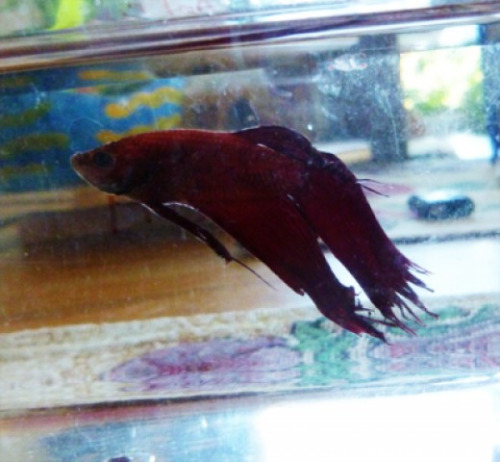
Almost every betta owner has dealt with an illness or disease at some point. Some illnesses are common, such as fin rot, while others are very rare, such as “mystery rot” (or necrosis).
Here is a basic look at common illnesses and diseases that may afflict bettas in the hobby:
Bacterial Infections:
- Fin rot/fin melt/pinhole rot
- Popeye
- Columnaris
- Septicemia
Parasitic Infections:
- Ich/ick/white spot
- Gill flukes
- Velvet
- Anchor worms
- Costia
Fungal:
- Fungus (very rare; most of what people think is a fungal infection is actually columnaris, a bacterial infection with fuzz as a secondary symptom).
Others:
- Dropsy
- Bloating
- “Mystery bloat”
- “Mystery rot” (or necrosis)
- Tumours/cysts
- Swim bladder issues
- Fatty liver disease
- Tail-biting issues
- Ammonia burns
- Hole-in-the-head
- Blindness
- Tuberculosis (very rare)
At the moment, I only have two guides for treating illnesses properly written up:
It’s important to know that many illnesses and diseases that bettas get are the results of poor water quality. This is why it’s crucial to properly cycle your aquarium, perform frequent water changes, and test the parameters regularly using a liquid water testing kit such as API Freshwater Master Test Kit. Even so, even with the most ideal conditions, illnesses can still occur but they’re typically not as common.
It’s also important that you don’t medicate unless you know what you’re dealing with. Medications are hard on fish and prolonged use can build resistance and also cause other problems. Also avoid any products like Bettafix, Melafix, or Pimafix since they contain tea tree oil that is dangerous to labyrinth fish.
Breeding
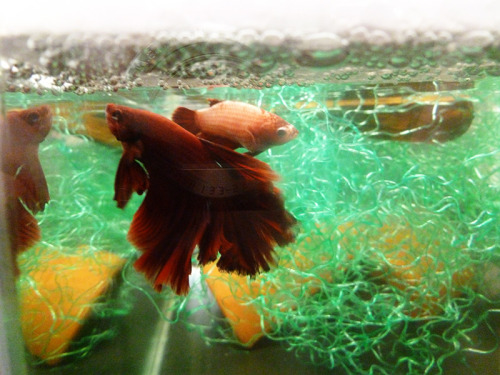
I have no personal experience with breeding at this time (the above picture of a betta pair courting was taken at the Holland Koi Show 2015). However, here are some breeding resources I’ve found to be informative:
- http://www.bettysplendens.com/spawning-bettas.html
- http://bubblesandbettas.blogspot.co.uk/p/breeding.html
- http://www.fishlore.com/fishforum/betta-breeding/37434-step-step-guide-breeding-bettas.html
And here are a couple of resources depicting betta fry growth:
(EDIT: I actually DO have experience breeding now, having bred Betta smaragdina guitar, which is a wild species of betta, for the first time. However, I don’t have a breeding/fry-raising guide done up at this point. You can see posts I made along the way HERE).
Other Articles Related to Betta Care
- Betta Care: How to Choose a Healthy Betta
- How to Play With Your Betta Fish
- Betta Care: Why Do Bettas Build Bubble Nests?
- Travelling With Betta Fish
Other Great Reads
- Betta Myths Debunked by scalestails
- What Is Aquarium Cycling? by scalestails
- Why Betta Bowls Are Bad by aquariadise
- 5 of the Stupidest Things I Learned After Owning Fish
- Betta Fish Often Mistreated by National Geographic
Other Betta Care Sheets
- Betta Care Sheet by aquariadise
- Betta Care Sheet by tser
- Betta Care Sheet by scalestails
- Betta Care Sheet by elemental-kiss
- Betta Care Graphic by bettablogging
If there are any other subjects you’d like to see expanded upon or included in this guide, please let me know!


















